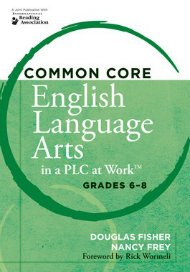Common Core English Language Arts in a PLC at Work
Common Core English Language Arts in a PLC at Work: Grades 6-8
By Douglas Fisher & Nancy Frey
Foreword by Rick Wormeli
(Solution Tree Press, 2013 – Learn more)

I’ve been trying to guide my instruction in a 7th grade ELA classroom by checking each standard and wondering if my current lessons can still be used. Will they mesh with the new Common Core State Standards? When the chance came up, I grabbed Common Core English Language Arts in a PLC at Work: Grades 6-8 by Douglas Fisher & Nancy Frey. Seeing the names of the authors alone convinced me this book would be valuable.

Effective PLCs have the following characteristics:
* Shared mission, values, and goals all focused on student learning
* A collaborative culture with a focus on learning
* Collective inquiry into best practice and current reality
* Action orientation
* A commitment to continuous improvement
* Results orientation
What the authors stress, however, is that PLCs need to reach agreement on fundamental issues. In order to do this, teachers need to have adequate time to collaborate with their colleagues.
I read this, and I pause. This looks like a dream world to me. I thought I’d have a difficult time reading the rest of the book – in regards to the PLC concept. Schools are like families… sometimes we work well together and other times not so much. It takes a special group to be able to pull this off, and to get “adequate time” needed as well! I found myself skimming the sections that talk about how to collaborate with other teachers, as we really aren’t afforded the time we would need. Once I’m afforded the time, I can revisit these sections.
Diving into the deep end of the standards
The main chapters dove into the standards in depth. Fisher and Frey did not “diss” the standards or commend them – they only framed them with effective vehicles for teachers in collaborative teams to build students’ proficiencies. As Rick Wormeli states in the foreword, “There’s no question that the book is written with the teacher in mind” (xi). This is verified. As you read through each section regarding anchor standards, you envision your students. The examples given from specific classes are activities teachers can try during the school year or easily apply to another piece of literature.
What I really found even more useful was the last chapter, “Implementing Formative Assessments to Guide Instruction.” The authors do not give specific formative assessments, but they give useful advice for what to do when students struggle. I found the charts included to be very applicable to my classes – and they’re something I can do even without the help of a PLC. This is what I’ll be using first: the error-analysis system, where all students can be on a single page. The simple and effective resources in the last chapter make more frequent formative assessments feasible.
I appreciate Solution Tree Press for including the websites that supplement this book (and others), including reproducibles, and I tip my hat to Douglas Fisher and Nancy Frey for once again giving teachers another resource that addresses our needs. If you teach ELA in grades 6-8, read this book before you decided to reform your Language Arts curriculum.
Joy Kirr currently teaches 7th grade LA & Literature in a suburb of Chicago. She was first a special education teacher working with deaf & hard-of-hearing students, and next became a reading specialist and nationally board certified. This is her 19th year of teaching, but she keeps learning more about education and children, so it’s always like her first!





























